Cash flow forecasting is not a luxury reserved for large corporations. For small and mid-sized businesses, especially those navigating growth, seasonality, or tight margins, creating an accurate cash flow forecast is essential for survival. Despite its importance, many business owners still confuse profit with cash flows, resulting in unexpected shortfalls, missed opportunities, or even insolvency.
The ability to forecast future cash flows and manage cash effectively can mean the difference between thriving and merely surviving in today's competitive business environment. An accurate forecast helps businesses anticipate cash shortages, plan for growth opportunities, and make informed business decisions about timing and resource allocation.
At Madras Accountancy, we help U.S.-based CPA firms support their clients by building cash flow forecasting models that are not only accurate but also practical to implement and monitor. With the right techniques and forecasting tools in place, small businesses can move beyond guesswork and use cash flow data to make informed decisions about hiring, purchasing, investing, and expansion.
In this guide, we break down what cash flow forecasting is, why it matters, the most reliable forecasting methods, how to choose the right forecasting tool, and how to build a cash flow forecast that actually reflects operational reality.
Cash flow forecasting is the systematic forecasting process of estimating how much money will flow in and out of a business over a specified forecasting period. It tracks actual cash movements and projected cash flows, not accounting profits, providing a clear picture of the business's liquidity position.
A comprehensive cash flow forecast typically includes:
Cash flow forecasts can be short-term (weekly or monthly) or long-term (quarterly or annually), depending on the business's needs and the specific forecasting period being analyzed. The forecast helps businesses understand not just how much cash they'll have, but when they'll have it.
Unlike profit and loss statements, a cash flow forecast shows when money is expected to hit or leave the bank account. This timing is critical for effective cash management. Even a profitable business can face serious challenges if it runs out of cash due to payment delays or poorly timed investments.
For small businesses, cash flows are the lifeblood of operations. Even a few weeks of negative cash flows can result in missed payroll, supplier disputes, or an inability to fulfill orders. An accurate cash flow forecast provides the visibility needed to manage cash effectively and avoid these critical situations.
Here are the most important reasons why forecasting cash flows should be a standard operating practice:
Knowing when cash flows are coming in and going out helps businesses avoid overdrafts, minimize interest on short-term loans, and better negotiate payment terms with suppliers. A detailed cash forecast enables proactive cash management rather than reactive responses to cash shortages.
An accurate forecast supports planning for seasonal inventory builds, marketing campaigns, hiring decisions, and capital expenditures. Instead of guessing, owners can see whether the business can afford specific investments and time them appropriately based on projected cash flows.
Banks and investors want to see that a business understands its cash position and can manage cash flow effectively. A detailed cash flow forecast strengthens loan applications and improves investor confidence by demonstrating financial planning capabilities.
The forecasting process enables stress testing of different scenarios. Businesses can model what happens to cash flows if sales drop, a major client delays payment, or expenses increase unexpectedly. This scenario planning helps identify potential cash shortages before they occur.
Creating a cash flow forecast forces business owners to evaluate fixed and variable costs, identify inefficient spending, and improve margins over time. The forecast helps identify patterns in cash flows that can inform strategic decisions.
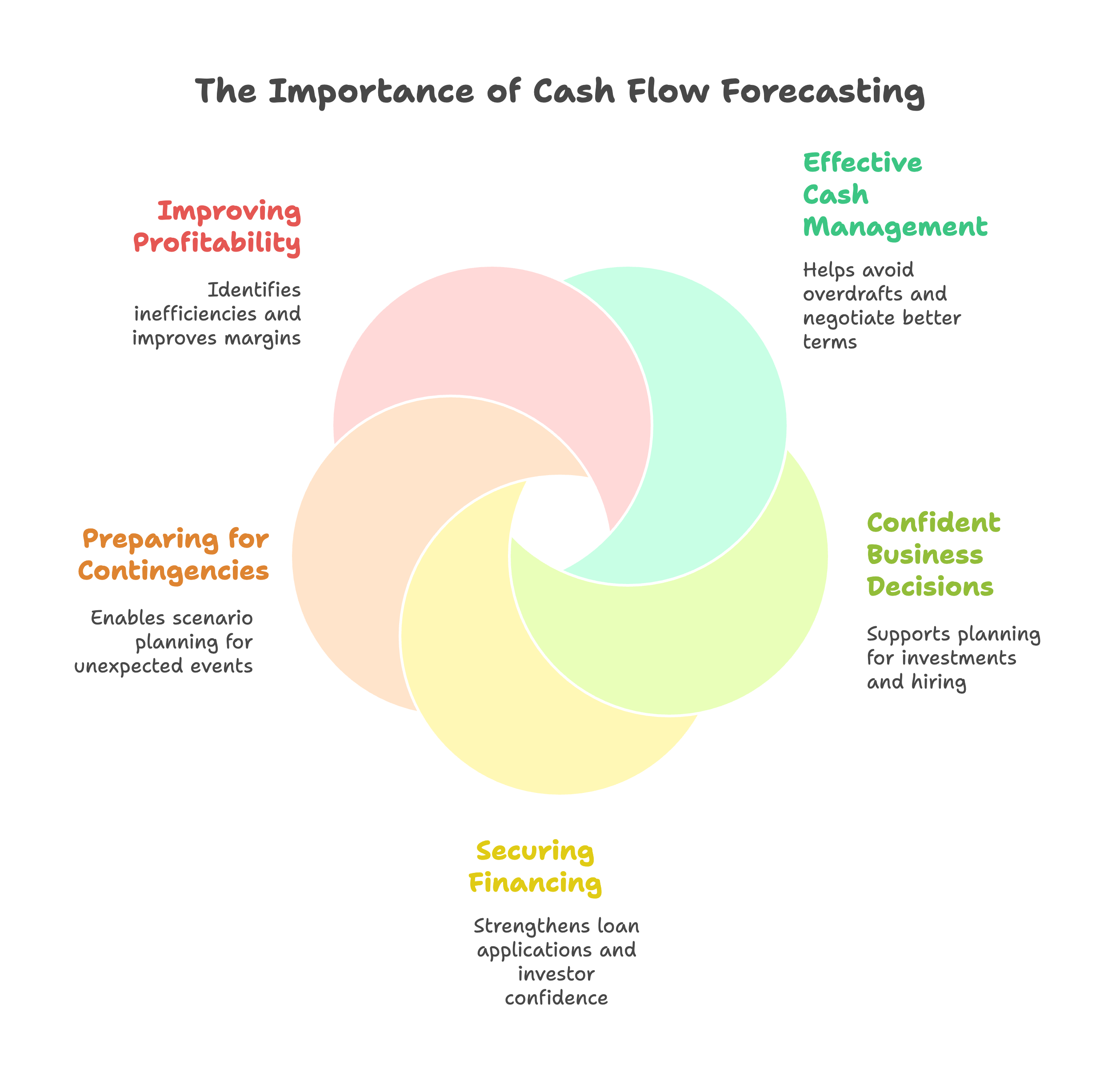
A comprehensive cash flow forecast is typically divided into three main sections: cash inflows, cash outflows, and net cash position. Understanding each component is essential for creating an accurate forecast.
This includes all the expected money entering the business during the forecasting period, such as:
Cash inflows should reflect realistic collection patterns rather than optimistic assumptions. For example, if your customers typically pay on 45-day terms, the cash forecast should not show all sales as immediate cash flows. Understanding your historical collection patterns is crucial for an accurate cash flow forecast.
This includes all payments the business expects to make during the forecasting period:
Categorizing outflows accurately in your cash forecast helps prioritize essential expenses and avoid surprises that could negatively impact cash flows.
Subtracting total outflows from total cash inflows gives the net cash flow for each period in the forecast. Add this to the opening cash balance to determine the projected cash balance at the end of each period.
Example Cash Flow Forecast:
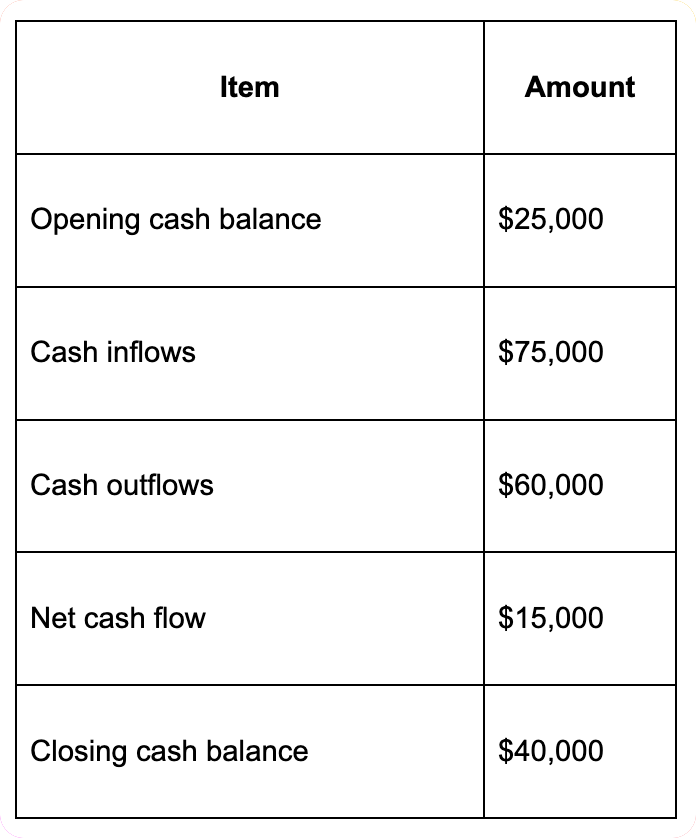
Maintaining a minimum cash balance based on your business's operating cycle and risk profile is good practice. The forecast helps ensure you maintain adequate cash flows to meet ongoing obligations.
There are two primary forecasting methods for predicting future cash flows: direct and indirect. Each serves different business needs and provides different levels of detail in the cash forecast.
Direct forecasting is a short-term method (usually 1 to 13 weeks) that focuses on actual expected cash movements based on real-time data. This approach to forecast cash flows is ideal for businesses managing liquidity on a day-to-day or week-to-week basis.
Advantages:
Best Used by:
Indirect forecasting uses projected financial statements (income statement and balance sheet) to estimate future cash flows. This forecasting method is better suited for long-term planning, investment decisions, and external reporting.
Advantages:
Best Used by:
The most effective approach often combines both forecasting methods — direct for daily cash management and indirect for long-term strategy. This combination provides both operational control and strategic insight into future cash flows.
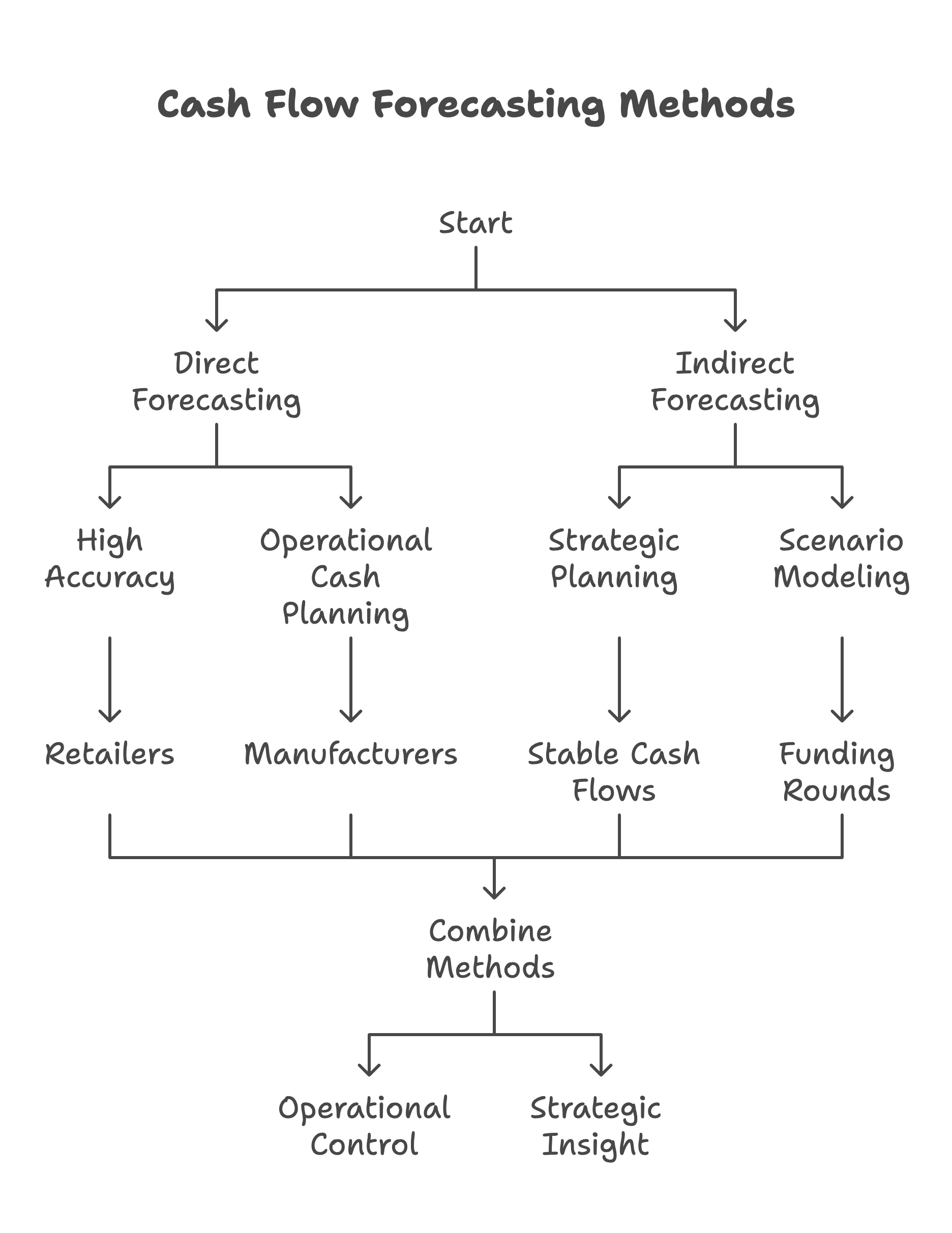
There is no single forecasting tool that works for every business. The best solution depends on the company's complexity, transaction volume, and existing tech stack. Here are common tools businesses and CPA firms use to forecast cash flows effectively:
Spreadsheets remain the most flexible and widely used option for early-stage or low-volume businesses. Custom cash flow forecasting models can be built to match any business model and forecasting period.
Pros:
Cons:
Many accounting platforms like QuickBooks Online, Xero, and Sage offer built-in forecasting capabilities or integrate with third-party cash flow forecasting software.
Pros:
Cons:
Specialized forecasting tools like Float, Fathom, Pulse, and Dryrun offer advanced features including scenario planning, graphical dashboards, and integration with bank feeds for comprehensive cash management.
Pros:
Cons:
CPA firms that offer outsourced accounting or CFO services often use these specialized forecasting tools to provide clients with consistent, reliable cash flow forecasts and ongoing cash management support.
Creating multiple versions of your cash flow forecast helps prepare for uncertainty and enables better cash management. Consider developing:
Best-Case Scenario:
Base-Case Scenario:
Worst-Case Scenario:
This approach to forecast cash flows helps identify potential cash shortages and enables proactive cash management strategies.
Instead of creating a static cash forecast, implement rolling forecasts that continuously update as new information becomes available. This dynamic forecasting process:
The most effective cash flow forecasts integrate with broader business planning processes:
This integrated approach ensures your cash forecast aligns with overall business strategy and enables more accurate cash management.
Regardless of the forecasting tools used, the quality of your cash flow forecast depends on discipline, realistic assumptions, and the willingness to revise as new data emerges.
Base your cash flow forecast on actual payment histories, average invoice settlement periods, and realistic sales expectations. Use historical data to inform your cash inflows projections rather than relying on optimistic assumptions that may not materialize.
Classify costs based on how they change with revenue in your cash forecast. This helps with scenario modeling and understanding your break-even point for cash flows. Fixed costs provide a baseline for minimum cash outflows, while variable costs scale with business activity.
Compare actual results against your cash flow forecast weekly or monthly to spot trends or inaccuracies. Use these insights to update future assumptions and improve the accuracy of your forecasting process.
Create best-case, base-case, and worst-case cash flow forecasts to evaluate how your cash position holds under different conditions. This scenario planning prepares your team for uncertainty and helps identify potential cash shortages.
Large one-time cash flows like tax refunds or equipment purchases can skew ongoing cash patterns. Tag them separately in your cash forecast to avoid misleading cash flow trends and maintain forecast accuracy.
Cash flow forecasting is not just a finance activity. Input from sales, procurement, operations, and HR ensures more accurate numbers in your cash forecast. Sales teams can provide better customer payment timing, while operations can improve expense timing accuracy.
Track indicators such as days sales outstanding (DSO), days payable outstanding (DPO), and operating cash ratio. These metrics help measure your working capital health and inform your cash management strategies.
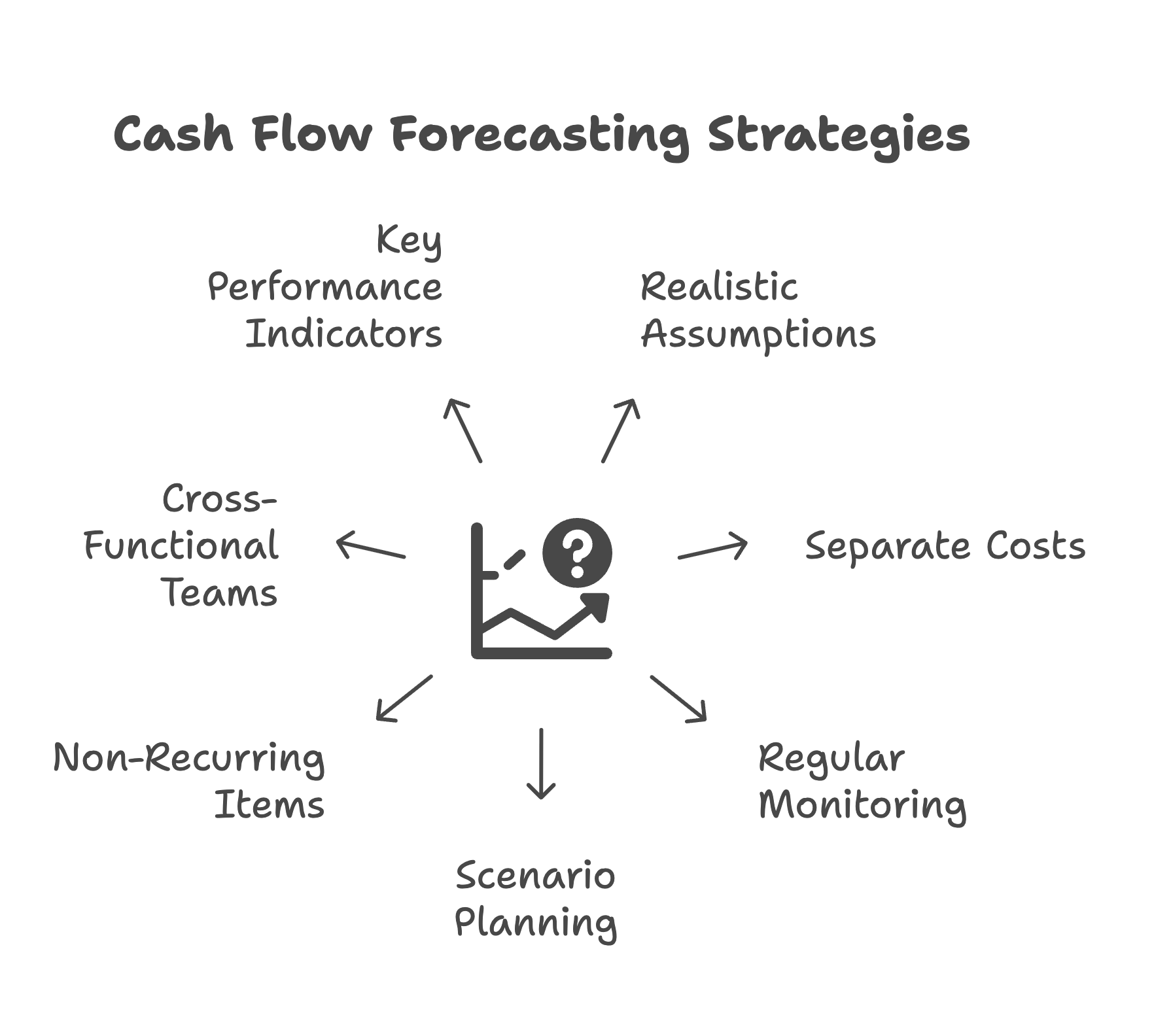
Automated cash flow systems provide several advantages over manual forecasting methods:
When evaluating cash flow forecasting software, consider these essential features:
Successfully implementing automated cash forecasting requires:
Small business owners often lack the time, tools, or financial knowledge to build reliable cash flow forecasts. CPA firms that provide cash flow forecasting support add tremendous value to their clients' financial management capabilities.
At Madras Accountancy, we work with U.S.-based CPA firms to support these services at scale. Our offshore team helps prepare cash flow forecasts, analyze cash flow cycles, and assist with management reporting, allowing firms to serve more clients without increasing overhead.
Problem: Overly optimistic sales forecasts lead to inflated cash inflow projections.
Solution: Base projections on historical data, current pipeline analysis, and conservative conversion assumptions. Track forecast accuracy and adjust methodologies based on actual results.
Problem: Customers pay later than expected, creating cash flow timing issues.
Solution: Analyze historical collection patterns by customer and incorporate realistic payment timing into your cash forecast. Implement stronger collection procedures and consider offering early payment discounts.
Problem: Seasonal businesses struggle to forecast cash flows during peak and off-peak periods.
Solution: Develop seasonal forecasting models based on multiple years of historical data. Plan cash management strategies for seasonal cash shortages and invest excess cash flows during peak periods.
Problem: Unplanned expenses disrupt cash flow forecasts and create cash shortages.
Solution: Build contingency allowances into cash outflow projections. Maintain a reserve fund for unexpected expenses and regularly review expense categories for potential variations.
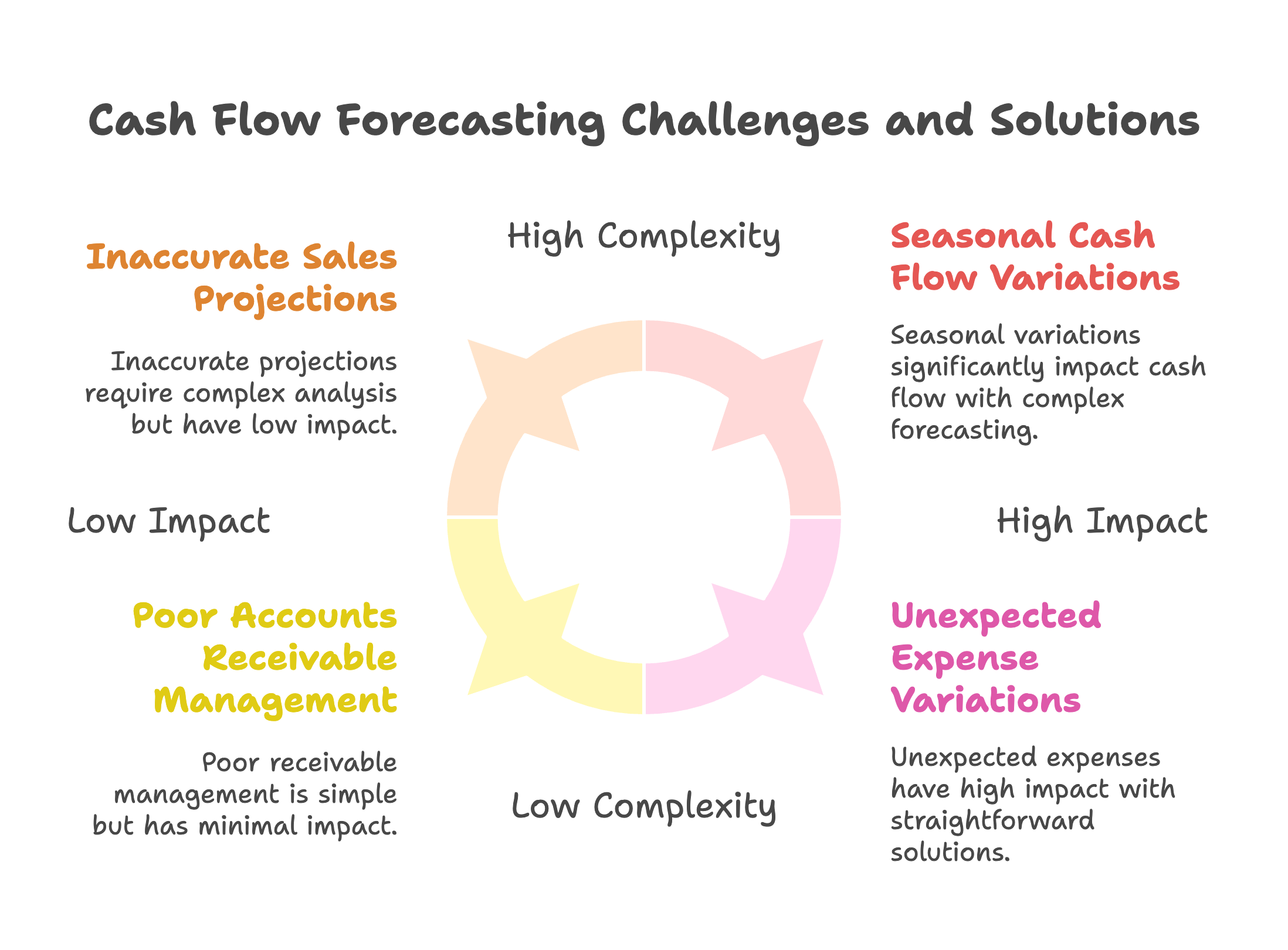
Modern cash flow forecasting software often includes API connectivity to pull data from multiple sources:
Advanced forecasting tools increasingly incorporate machine learning to:
Modern forecasting tools provide mobile access for:
Track these metrics to evaluate your cash flow forecasting effectiveness:
Establish a regular review process to enhance your cash flow forecasting:
AI-powered forecasting tools are beginning to offer:
Emerging technologies enable:
Future forecasting platforms will provide:
Cash flow forecasting is no longer optional for growing businesses. It represents a vital discipline that enables proactive planning, efficient capital use, and strategic resilience. Whether your client is managing seasonal fluctuations, preparing for funding, or recovering from a downturn, clear visibility into future cash flows is essential for effective cash management.
An accurate cash flow forecast serves as the foundation for sound business decisions, enabling companies to anticipate cash shortages, optimize cash flows timing, and invest confidently in growth opportunities. The forecasting process itself often reveals insights about business operations that lead to improved efficiency and profitability.
The right forecasting tools, paired with proven forecasting methods and professional guidance, can transform cash flow forecasting from a back-office task into a strategic asset. Whether you use simple spreadsheets or sophisticated cash flow forecasting software, the key is consistency in the forecasting process and regular updates based on actual cash flows performance.
For CPA firms, offering cash flow forecasting support represents a high-value service that directly impacts client success. The ability to help clients manage cash effectively, avoid cash shortages, and make informed business decisions based on accurate forecasts strengthens the advisory relationship and demonstrates tangible value.
Madras Accountancy partners with CPA firms to deliver high-quality cash flow forecasting and financial planning support, helping businesses of all sizes stay prepared, make smarter choices, and grow with confidence. Our offshore team provides the expertise and resources needed to implement effective cash management systems that support long-term business success.
Question: What is cash flow forecasting and why is it essential for business financial management?
Answer: Cash flow forecasting is the process of predicting future cash inflows and outflows to anticipate liquidity needs and financial position over specific periods. This essential financial management tool helps businesses avoid cash shortages, plan for growth investments, negotiate better terms with suppliers and lenders, and make informed strategic decisions. Accurate cash flow forecasting enables businesses to identify potential funding needs, optimize working capital, time major expenditures appropriately, and maintain adequate cash reserves for operations and opportunities.
Question: What are the key components and elements of effective cash flow forecasting?
Answer: Effective cash flow forecasting includes operating cash flows (revenue collections, supplier payments, payroll, overhead), investing activities (equipment purchases, asset sales), and financing activities (loan payments, equity investments, dividend distributions). Key components cover accounts receivable collections, accounts payable timing, inventory purchases, seasonal variations, and one-time transactions. Consider payment terms, collection patterns, expense timing, tax obligations, and capital expenditure plans. Include conservative and optimistic scenarios to understand potential variations and prepare for different business conditions and market changes.
Question: What tools and software are available for business cash flow forecasting?
Answer: Cash flow forecasting tools range from Excel spreadsheets to specialized software platforms including Pulse, Cashflow360, Float, and PlanGuru for dedicated cash flow management. Accounting software like QuickBooks, Xero, and NetSuite offer built-in forecasting features, while ERP systems provide integrated forecasting capabilities. Advanced tools include Adaptive Insights, Workday Planning, and Oracle Planning for enterprise-level forecasting. Many businesses start with Excel templates and graduate to specialized tools as complexity and accuracy requirements increase. Choose tools based on business size, complexity, integration needs, and collaboration requirements.
Question: How far ahead should businesses forecast cash flow and how frequently should forecasts be updated?
Answer: Businesses should maintain rolling 13-week cash flow forecasts for operational planning, with monthly forecasts extending 12-18 months for strategic planning purposes. Weekly forecasting provides tactical cash management guidance, while quarterly updates support longer-term planning and funding decisions. High-growth or seasonal businesses may need daily forecasting during critical periods. Update forecasts weekly or bi-weekly, incorporating actual results and revised projections. Maintain multiple scenarios (conservative, most likely, optimistic) and adjust frequency based on business volatility, cash position, and market conditions.
Question: What are the common challenges and pitfalls in cash flow forecasting?
Answer: Common cash flow forecasting challenges include overly optimistic revenue projections, underestimating collection periods, failing to account for seasonal variations, and ignoring one-time expenses or timing delays. Pitfalls include static forecasts that aren't updated regularly, lack of scenario planning, insufficient historical data analysis, and poor communication between departments providing forecast inputs. Many businesses struggle with accurately predicting customer payment timing, seasonal fluctuations, and unexpected expenses. Address challenges through conservative assumptions, regular forecast updates, cross-departmental collaboration, and scenario analysis for better accuracy.
Question: How can businesses improve the accuracy of their cash flow forecasting?
Answer: Improve cash flow forecasting accuracy by analyzing historical patterns, using conservative revenue estimates, tracking actual versus projected results, and incorporating multiple scenarios into planning. Monitor key metrics like days sales outstanding, payment patterns by customer segment, and seasonal trends to refine projections. Collaborate with sales, operations, and purchasing teams for better input data, implement rolling forecasts that incorporate actual results, and use probabilistic modeling for uncertain events. Regular forecast reviews and variance analysis help identify improvement opportunities and refine future projections.
Question: How does cash flow forecasting support business decision-making and planning?
Answer: Cash flow forecasting supports critical business decisions including investment timing, hiring plans, inventory purchases, expansion opportunities, and financing needs. It helps businesses evaluate the cash impact of strategic initiatives, assess the feasibility of growth plans, and determine optimal timing for major expenditures. Forecasting enables proactive communication with lenders and investors, supports budget planning, and guides working capital optimization strategies. Businesses use forecasts to negotiate payment terms, plan marketing campaigns, and make informed decisions about operational changes and strategic investments.
Question: What role does cash flow forecasting play in securing business financing?
Answer: Cash flow forecasting is essential for securing business financing as lenders and investors require detailed projections to assess repayment ability and business viability. Banks use forecasts to evaluate loan applications, determine credit limits, and structure repayment terms. Investors review projections to understand funding needs, growth potential, and risk factors. Accurate forecasts demonstrate management competence, support funding requests with data, and help negotiate favorable terms. Include sensitivity analysis and scenario planning to show understanding of risks and mitigation strategies, building confidence with financial partners and stakeholders.
.png)
December 9, 2025
A straight-talking overview of five small business tax prep options in 2025, including Madras Accountancy, TurboTax, H&R Block, TaxSlayer, and Bench’s books-plus-tax model.

December 9, 2025
An on-the-ground guide to the UK’s fractional CFO ecosystem – London and beyond – including The CFO Centre, fin-house, FD Capital, BKL, BSmart, and how Madras Accountancy fits into cross-border and hybrid models.